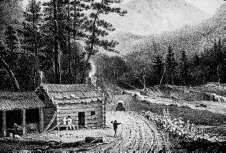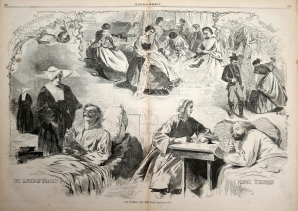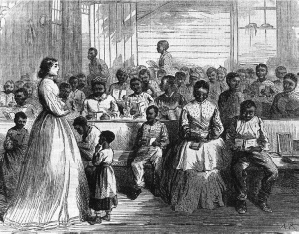During the period of 1820-1860, the life of white and black people in the South depended on developing the Institute of slavery which shaped not only social but also economic life of the region. The Institute of slavery was primarily for the Southern states, and this feature helped to distinguish the South from the other regions of the USA.
Slavery played the key role in shaping the economic and social life of the South because it influenced the trade and economic relations in the region as well as the social and class structure representing slave owners, white farmers without slaves, and slaves as the main labor force in the region.
The development of the South during the period of 1820-1860 was based on growing cotton intensively. To guarantee the enormous exports of cotton, it was necessary to rely on slaves as the main cheap or almost free workforce. The farmers of the South grew different crops, but the economic success was associated with the farms of those planters who lived in the regions with fertile soil and focused on growing cotton basing on slavery.
Thus, the prosperity of this or that white farmer and planter depended on using slaves in his farm or plantation. Slaves working for planters took the lowest social positions as well as free slaves living in cities whose economic situation was also problematic. The white population of the South was divided into slave owners and yeoman farmers who had no slaves.
Thus, having no opportunities to use the advantages of slavery, yeoman farmers relied on their families’ powers, and they were poorer in comparison with planters (Picture 1). However, not all the planters were equally successful in their economic situation. Many planters owned only a few slaves, and they also had to work at their plantations or perform definite duties.
Slaves were also different in their status because of the functions performed. From this point, the social stratification was necessary not only for dividing the Southern population into black slaves and white owners but also to demonstrate the differences within these two main classes (Davidson et al.).
As a result, different social classes had various cultures. It is important to note that slaves were more common features in spite of their status in families, and they were united regarding the culture which was reflected in their religion, vision, and songs. The difference in the social status of the white population was more obvious, and the single common feature was the prejudice and discrimination against slaves.
Picture 1. Yeoman Farmer’s House

The Civil War became the real challenge for the USA because it changed all the structures and institutions of the country reforming the aspects of the political, economic, and social life. Furthermore, the Civil War brought significant losses and sufferings for both the representatives of the Northern and Southern armies.
It is important to note that the situation of the Union in the war was more advantageous in comparison with the position of the Confederacy during the prolonged period of the war actions.
As a result, the South suffered from more significant economic and social changes as well as from extreme losses in the war in comparison with the North’s costs. Thus, the main impact of the Civil War was the abolition of slavery which changed the economic and social structures of the South and contributed to shifting the focus on the role of federal government.
The Civil War resulted in abolishing slavery and preserving the political unity of the country. Nevertheless, these positive outcomes were achieved at the expense of significant losses in the number of population and in promoting more sufferings for ordinary people. A lot of the Confederacy’s soldiers died at the battlefields, suffering from extreme wounds and the lack of food because of the problems with weapon and food provision.
During the war, the Union focused on abolishing slaves who were proclaimed free. Thus, former slaves from the Southern states were inclined to find jobs in the North or join the Union army.
As a result, the army of the Confederacy also began to suffer from the lack of forces (Davidson et al.). Moreover, the situation was problematic off the battlefield because all the issues of food provision and work at plantations and farms challenged women living in the Southern states.
The forces of the Union army were more balanced, and their losses were less significant than in the Southern states. Furthermore, the end of the war did not change the structure of the social life in the North significantly. The impact of the war was more important for the Southerners who had to build their economic and social life without references to slavery.
The next important change was the alternations in the social role of women. Many women had to work at farms in the South and to perform as nurses in the North (Picture 2). The vision of the women’s role in the society was changed in a way.
However, in spite of the fact that the population of the South had to rebuild the social structure and adapt to the new social and economic realities, the whole economic situation was changed for better with references to intensifying the international trade. Furthermore, the abolishment of slavery was oriented to the social and democratic progress in the country.
Picture 2. “Our Women and the War”. Harper’s Weekly, 1862

Theme Essays. Diversity
Diversity is one of the main characteristic features of the American nation from the early periods of its formation. The American nation cannot be discussed as a stable one because the formation of the nation depends on the active migration processes intensifying the general diversity. As a result, the American nation is characterized by the richness of cultures, values, and lifestyles.
This richness is also typical for the early period of the American history when the country’s population was diverse in relation to ethnicity, cultures, religion, and social status. From this point, diversity directly shaped the American nation because the country’s population never was identical.
The Americans respected diversity if the question was associated with the problem of first migrations and the Americans’ difference from the English population. To win independence, it was necessary to admit the difference from the English people, but diversity was also the trigger for conflicts between the Americans, Englishmen, and Frenchmen as well as Indian tribes.
The ethic diversity was not respected by the first Americans. The further importations of slaves to America worsened the situation, and ethnic diversity increased, involving cultural and social diversity.
Diversity was respected only with references to the negative consequences of slave importation. Thus, the Southerners focused on using black slaves for development of their plantations (Davidson et al.). From this point, white planers concentrated on the difference of blacks and used it for discrimination.
Furthermore, slavery also provoked the cultural and lifestyle diversity between the South and the North of the country which resulted in the Civil War because of impossibility to share different values typical for the Southerners and Northerners. Moreover, the diversity in lifestyles of the Southerners was deeper because it depended on the fact of having or not slaves.
Great religious diversity was also typical for the nation. White population followed different branches of Christianity relating to their roots, and black people developed their own religious movements contributing to diversifying the religious life of the Americans (Davidson et al.).
Thus, the aspects of diversity are reflected in each sphere of the first Americans’ life with references to differences in ethnicities, followed religions, cultures, values, lifestyles, and social patterns. This diversity also provoked a lot of conflicts in the history of the nation.
Questions
Women
The role of women in the American society changed depending on the most important political and social changes. The periods of reforms and transformations also promoted the changes in the social positions of women. The most notable changes are typical for the period of the Jacksonian era and for the Civil War period.
The changes in the role of women are closely connected with the development of women’s movements during the 1850s and with the focus on women’s powers off the battlefield during the Civil War period.
During the Jacksonian era, women began to play significant roles in the religious and social life of the country. Having rather limited rights, women could realize their potentials only in relation to families and church work. That is why, many women paid much attention to their church duties and responsibilities.
Later, the church work was expanded, and women began to organize special religious groups in order to contribute to reforming definite aspects of the Church’s progress. Women also were the main members of the prayer meetings, and much attention was drawn to the charity activities and assistance to hospitals (Davidson et al.).
Women also played the significant role in the development of revivalism as the characteristic feature of the period. Moreover, the active church work and the focus on forming organizations was the first step to the progress of the women’s rights movements.
It is important to note that the participation of women in the social life was rather limited during a long period of time that is why membership and belonging to different church organizations as well as development of women’s rights movements contributed to increasing the role of women within the society. Proclaiming the necessity of abolishment, socially active women also concentrated on the idea of suffrage which was achieved later.
The period of the 1850s is closely connected with the growth of the women’s rights movements because it was the period of stating to the democratic rights and freedoms within the society (Davidson et al.). The next important event is the Civil War. The war influenced the position of the Southern white and black women significantly, revealing their powers and ability to overcome a lot of challenges.
The end of the Civil War provided women with the opportunity to achieve all the proclaimed ideals of the women’s rights movements along with changing the position of male and female slaves in the American society.
Values
The development of the American nation is based on pursuing certain ideals and following definite values. The main values which are greatly important for the Americans are associated with the notions which had the significant meaning during the periods of migration and creating the independent state. The two main values are opportunity and equality.
These values are also fixed in the Constitution of the country in order to emphasize their extreme meaning for the whole nation.
Opportunity and equality are the values which are shaped with references to the economic and social ideals because all the Americans are equal, and each American should have the opportunity to achieve the individual goal. Nevertheless, in spite of the proclaimed ideals, the above-mentioned values were discussed during a long period of time only with references to the white population of the country.
The other values typical for the Americans are also based not on the religious, moral or cultural ideals but on the social aspects. During the Jacksonian era, the Americans focused on such values as the democratic society. Following the ideals of rights and freedoms, the American population intended to realize them completely within the developed democratic society (Davidson et al.).
Moreover, these ideals were correlated with such values as equality and opportunity. It is necessary to pay attention to the fact that for many Americans the notions of democratic society, opportunity, and equality were directly connected with the economic growth. That is why, during long periods of time Americans concentrated on achieving freedoms along with pursuing the economic prosperity.
Thus, it is possible to determine such key values which regulate the social attitudes and inclinations of the Americans as equality and opportunity, freedoms and rights. In spite of the fact the USA was the country with the determined role of religion in the society, moral and religious aspects were not proclaimed as the basic values of the nation because of the prolonged focus of the Americans on their independence and prosperity.
From this point, opportunity, equality, freedoms, and rights are discussed as more significant values for the developed nation than the religious principles. The creation of the state independent from the influence of the British Empire resulted in determining the associated values and ideals which were pursued by the Americans during prolonged periods of the nation’s development.
Extra Credit Option. Reconstruction
The period of Reconstruction was oriented to adapting African Americans to the realities of the free social life and to rebuilding the economic structure of the South. The end of the Civil War guaranteed the abolishment of slavery, but the question of black people’s equality to the whites was rather controversial.
That is why, the period of Reconstruction was rather complex and had two opposite outcomes for the African Americans’ further life in the society and for the general economic progress of the states. Reconstruction was successful in providing such opportunities for African Americans as education and a choice to live in any region or to select the employer.
However, Reconstruction can also be discussed as a failure because the issues of racism were not overcome during the period, and the era of slavery was changed with the era of strict social segregation leading to significant discrimination of black people.
The positive changes in the life of African Americans after the Civil War were connected with receiving more opportunities for the social progress. Thus, many public schools were opened for the black population in order to increase the level of literacy (Picture 3). Furthermore, the impossibility to support the Southerners’ plantations without the free work of slaves led to changing the economic focus.
Thus, industrialization of the region could contribute to creating more workplaces for African Americans (Davidson et al.). Moreover, the racial and social equality should also be supported with references to providing more political rights for African Americans.
Reconstruction was the period of observing many black politicians at the American political arena. The question of blacks’ suffrage became one of the most discussed issues. From this point, during the period of Reconstruction African Americans did first steps on the path of equality.
Nevertheless, Reconstruction was also a great failure. The South remained unchanged in relation to the social relations between the whites and blacks. After the Civil War, segregation was intensified. The economic and social pressure as well as discrimination against the blacks was based on the developed concept of racism (Davidson et al.).
The Southerners preserved the prejudiced attitude toward the blacks, and prejudice and discrimination became the main challenge for African Americans in all the spheres of the life.
In spite of definite successes of Reconstruction, African Americans suffered from the results of segregation and discrimination, and they were prevented from changing their economic and social status.
Picture 3. Public Schools

Works Cited
Davidson, James, Brian DeLay, Christine Leigh Heyrman, Mark Lytle, and Michael Stoff. US: A Narrative History. USA: McGraw-Hill, 2008. Print.